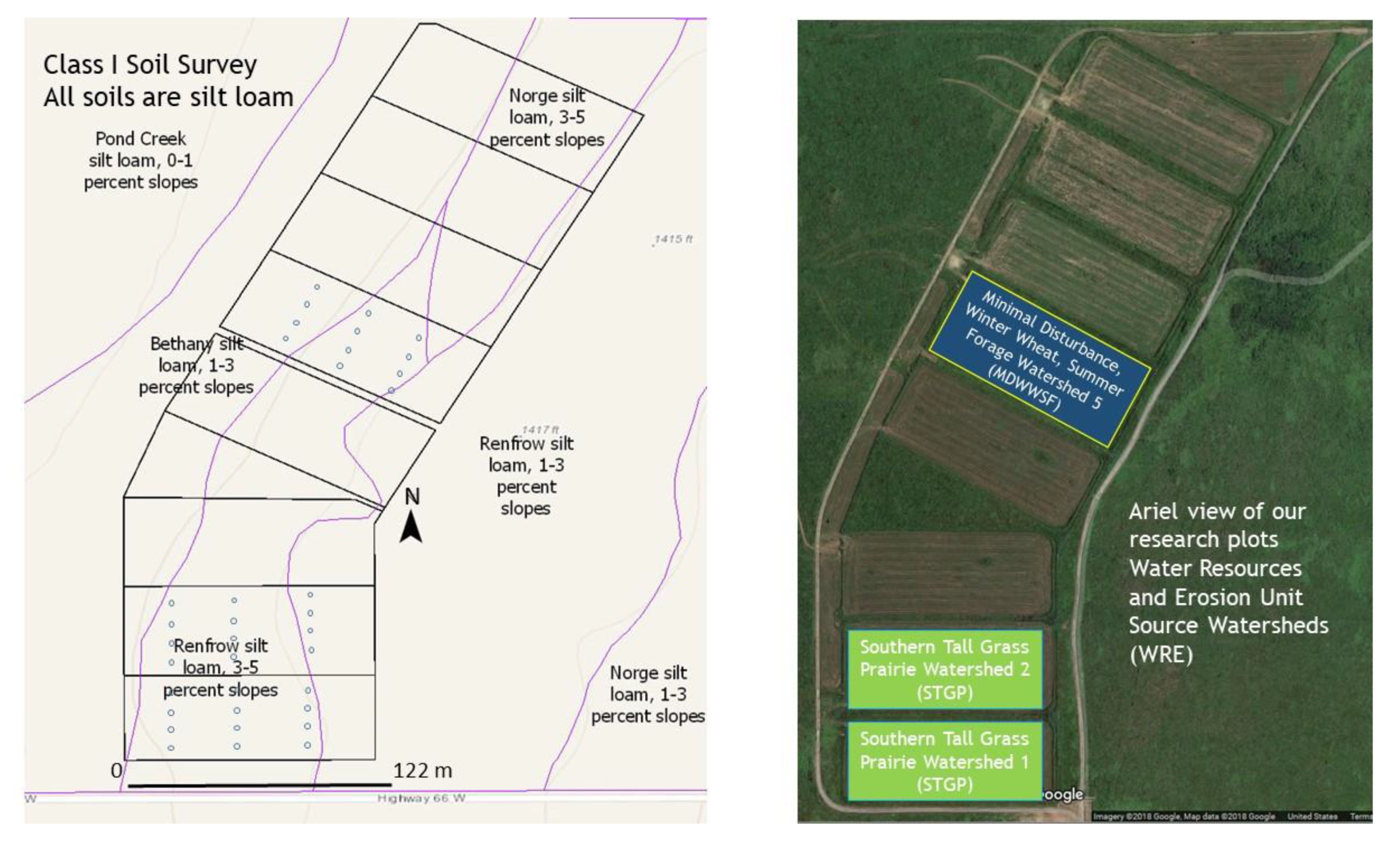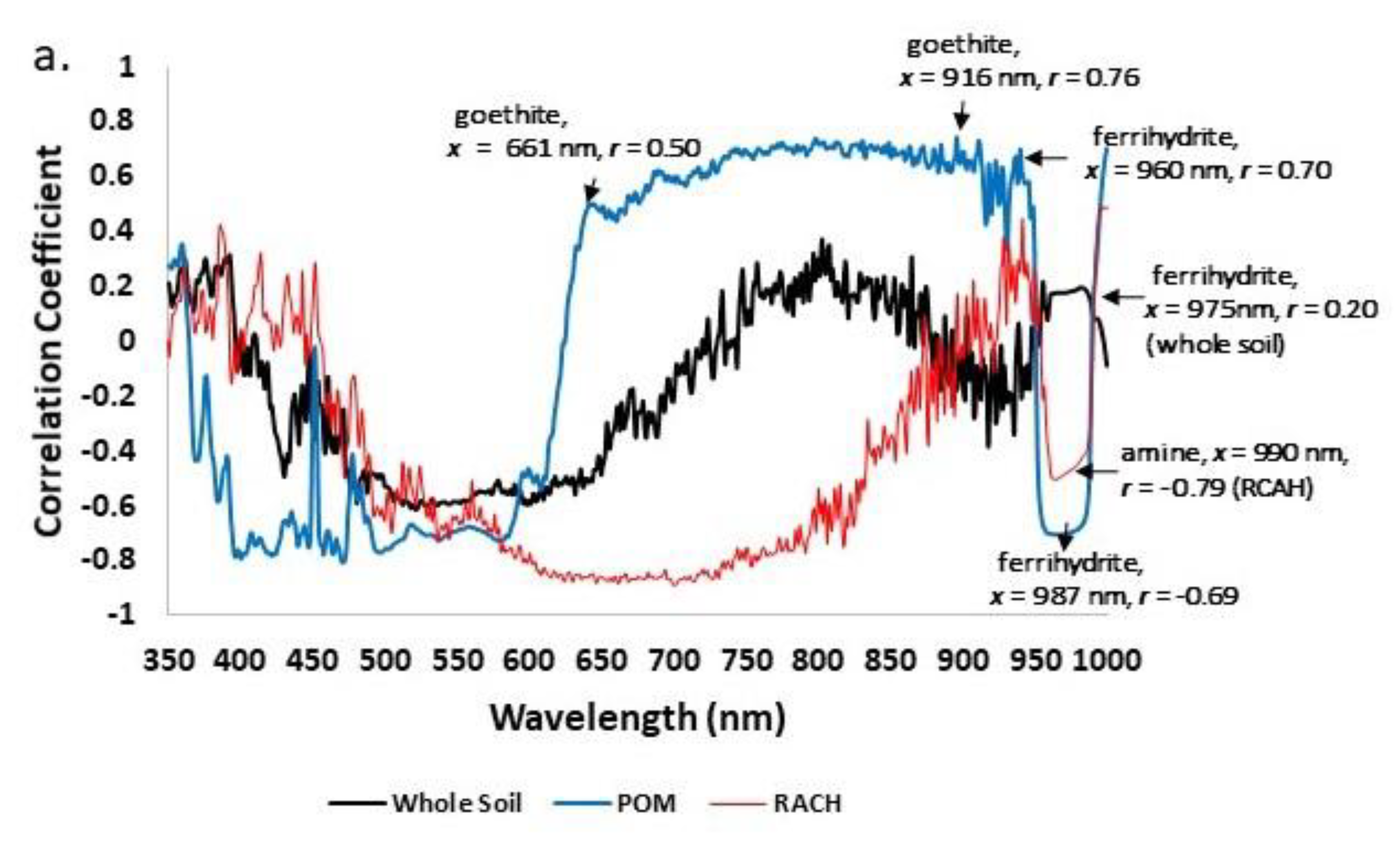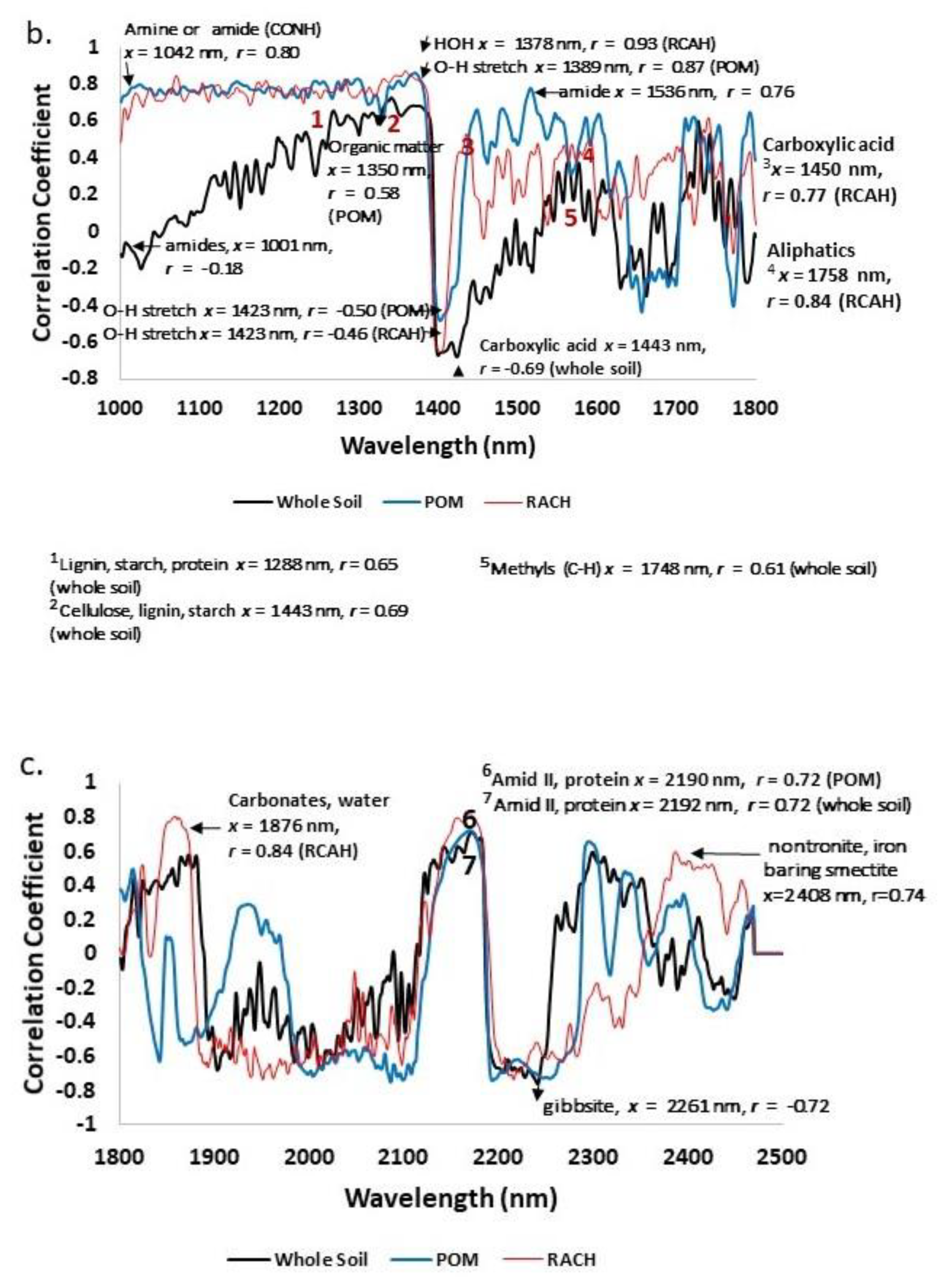Prediction of Soil Carbon Fractions Using a Field Spectroradiometer Equipped with an Illuminating Contact Probe
Abstract
1. Introduction
2. Materials and Methods
2.1. Watershed Descriptions and Soil Sampling
2.2. Soil Analysis
2.3. Spectroradiometry Measurements
2.4. Calibration and Statistical Treatment of Spectroradiometry Data
2.5. Statistical Analyses
3. Results and Discussion
3.1. Soil Properties and Organic Fractions
3.2. Calibration and Validation of Reflectance-Based Algorithms
3.3. Comparison of Spectral Data in Soil C and N Fractions
4. Conclusions
Author Contributions
Funding
Acknowledgments
Conflicts of Interest
Disclaimers
References
- Fortuna, A.-M.; Honeycutt, C.W.; Vandemark, G.; Griffin, T.S.; Larkin, R.P.; He, Z.; Wienhold, B.J.; Sistani, K.R.; Albrecht, S.L.; Woodbury, B.L.; et al. Links among nitrification, nitrifier communities, and edaphic properties in contrasting soils receiving dairy slurry. J. Environ. Qual. 2012, 41, 262–272. [Google Scholar] [CrossRef] [PubMed]
- Doran, J.W.; Parkin, T.B.; Doran, J.W. Defining and assessing soil quality. In Defining Soil Quality for Sustainable Environment; No. 631.4 D313d; Soil Science Society of America: Madison, WI, USA, 1994; pp. 3–21. [Google Scholar]
- Karlen, D.L.; Ditzler, C.A.; Andrews, S.S. Soil quality: Why and how? Geoderma 2003, 114, 145–156. [Google Scholar] [CrossRef]
- Paul, E.A.; Morris, S.J.; Conant, R.T.; Plante, A.F. Does the acid hydrolysis–incubation method measure meaningful soil organic carbon pools? Soil Sci. Soc. Am. J. 2006, 70, 1023–1035. [Google Scholar] [CrossRef]
- Plante, A.F.; Conant, R.T.; Paul, E.A.; Paustian, K.; Six, J. Acid hydrolysis of easily dispersed and microaggregate-derived silt-and clay-sized fractions to isolate resistant soil organic matter. Eur. J. Soil Sci. 2006, 57, 456–467. [Google Scholar] [CrossRef]
- Paul, E.A.; Morris, S.J.; Böhm, J.S.; Lal, R. (Eds.) The determination of soil C pool sizes and turnover rates: Biophysical fractionation and tracers. In Assessment Methods for Soil Carbon; Advances in Soil Science; CRC Press: Boca Raton, FL, USA, 2001; pp. 193–206. [Google Scholar]
- Gregorich, E.G.; Carter, M.R.; Angers, D.A.; Monreal, C.M.; Ellert, B.H. Towards a minimum data set to assess soil organic matter quality in agricultural soils. Can. J. Soil Sci. 1994, 74, 367–385. [Google Scholar] [CrossRef]
- Fortuna, A.-M.; Harwood, R.R.; Paul, E.A. The effects of compost and crop rotations on carbon turnover and the particulate organic matter fraction. Soil Sci. 2003, 168, 434–444. [Google Scholar] [CrossRef]
- Bhowmik, A.; Fortuna, A.M.; Cihacek, L.J.; Bary, A.I.; Carr, P.M.; Cogger, C.G. Potential carbon sequestration and nitrogen cycling in long-term organic management systems. Renew. Agric. Food Syst. 2017, 32, 498–510. [Google Scholar] [CrossRef]
- Gregorich, E.G.; Beare, M.H.; Carter, M.R.; Gregorich, E.G. (Eds.) Physically uncomplexed organic matter. In Soil Sampling and Methods of Analysis, 2nd ed.; CRC Press: Boca Raton, FL, USA, 2008; pp. 607–616. [Google Scholar]
- Fortuna, A.; Harwood, R.; Kizilkaya, K.; Paul, E.A. Optimizing nutrient availability and potential carbon sequestration in an agroecosystem. Soil Biol. Biochem. 2003, 35, 1005–1013. [Google Scholar] [CrossRef]
- Leavitt, S.W.; Follett, R.F.; Paul, E.A. Estimation of slow- and fast-cycling soil organic carbon pools from 6N HCl hydrolysis. Radiocarbon 1996, 38, 231–239. [Google Scholar] [CrossRef]
- Paul, E.A.; Harris, D.; Collins, H.P.; Schulthess, U.; Robertson, G.P. Evolution of CO2 and soil carbon dynamics in biologically managed, row-crop agroecosystems. Appl. Soil Ecol. 1999, 11, 53–65. [Google Scholar] [CrossRef]
- Gollany, H.T.; Fortuna, A.M.; Samuel, M.K.; Young, F.L.; Pan, W.L.; Pecharko, M. Soil organic carbon accretion vs. sequestration using physicochemical fractionation and CQESTR simulation. Soil Sci. Soc. Am. J. 2013, 77, 618–629. [Google Scholar] [CrossRef]
- Martel, Y.A.; Paul, E.A. Effects of cultivation on organic matter of grassland soils as determined by fractionation and radiocarbon dating. Can. J. Soil Sci. 1974, 54, 419–426. [Google Scholar] [CrossRef]
- Follett, R.F.; Paul, E.A.; Leavitt, S.W.; Halvorson, A.D.; Lyon, D.; Peterson, G.A. Carbon isotope ratios of great plains soils and in wheat-fallow systems. Soil Sci. Soc. Am. J. 1997, 61, 1068–1077. [Google Scholar] [CrossRef]
- Knadel, M.; Viscarra Rossel, R.A.; Deng, F.; Thomsen, A.; Greve, M.H. Visible–near infrared spectra as a proxy for topsoil texture and glacial boundaries. Soil Sci. Soc. Am. J. 2012, 77, 568–579. [Google Scholar] [CrossRef]
- Wander, M.M.; Traina, S.J. Organic matter fractions from organically and conventionally managed soils: II. Characterization of composition. Soil Sci. Soc. Am. J. 1996, 60, 1087–1094. [Google Scholar] [CrossRef]
- Yang, X.M.; Xie, H.T.; Drury, C.F.; Reynolds, W.D.; Yang, J.Y.; Zhang, X.D. Determination of organic carbon and nitrogen in particulate organic matter and particle size fractions of Brookston clay loam soil using infrared spectroscopy. Eur. J. Soil Sci. 2012, 63, 177–188. [Google Scholar] [CrossRef]
- Zhang, L.; Yang, X.; Drury, C.; Chantigny, M.; Gregorich, E.; Miller, J.; Bittman, S.; Reynolds, D.; Yang, J. Infrared spectroscopy prediction of organic carbon and total nitrogen in soil and particulate organic matter from diverse Canadian agricultural regions. Can. J. Soil Sci. 2017, 98, 77–90. [Google Scholar] [CrossRef]
- Elliott, E.T.; Cambardella, C.A. Physical separation of soil organic matter. Agric. Ecosyst. Environ. 1991, 34, 407–419. [Google Scholar] [CrossRef]
- Calderón, F.J.; Reeves, J.B.; Collins, H.P.; Paul, E.A. Chemical differences in soil organic matter fractions determined by diffuse-reflectance mid-infrared spectroscopy. Soil Sci. Soc. Am. J. 2011, 75, 568–579. [Google Scholar] [CrossRef]
- Soil Science Division Staff. Soil Survey Manual, USDA Handbook 18; Government Printing Office: Washington, DC, USA, 2017.
- Goodman, J.M.; Morris, J.W. Physical Environments of Oklahoma; Geography of Oklahoma: Oklahoma City, OK, USA, 1977; pp. 9–25. [Google Scholar]
- Daniel, J.A. Geology and Groundwater Resources of Canadian County, Oklahoma; Research Report GRL 1-02; USDA-ARS Grazinglands Research Laboratory: El Reno, OK, USA, 2002.
- Mesonet, El Reno, OK, USA. Available online: http:// https://www.mesonet.org (accessed on 12 September 2019).
- Terhoeven-Urselmans, T.; Helfrich, M.K.; Flessa, M.H.; Ludwig, B. Near-infrared spectroscopy can predict the composition of organic matter in soil and litter. J. Plant Nutr. Soil Sci. 2006, 169, 168–174. [Google Scholar] [CrossRef]
- Northup, B.K.; Daniel, J.A. Distribution of soil bulk density and organic matter along an elevation gradient in central Oklahoma. Trans. ASABE 2010, 53, 1749–1757. [Google Scholar] [CrossRef]
- Janik, L.J.; Forrester, S.T.; Rawson, A. The prediction of soil chemical and physical properties from mid-infrared spectroscopy and combined partial least-squares regression and neural networks (PLS-NN) analysis. Chemom. Intell. Lab. Syst. 2009, 97, 179–188. [Google Scholar] [CrossRef]
- Rossel, R.A.V.; Hicks, W.S. Soil organic carbon and its fractions estimated by visible-near infrared transfer functions. Eur. J. Soil Sci. 2015, 66, 438–450. [Google Scholar] [CrossRef]
- Anderson, D.W.; Saggar, S.; Bettany, J.R.; Stewart, J.W.B. Particle size fractions and their use in studies of soil organic matter 1. The nature and distribution of forms of carbon, nitrogen, and sulfur. Soil Sci. Soc. Am. J. 1981, 45, 767–772. [Google Scholar] [CrossRef]
- Anderson, D.W.; Paul, E.A. Organo-mineral complexes and their study by radiocarbon dating. Soil Sci. Soc. Am. J. 1984, 48, 298–301. [Google Scholar] [CrossRef]
- Stenberg, B.; Rossel, R.A.V.; Mouazen, A.M.; Wetterlind, J. Visible and near infrared spectroscopy in soil science. In Advances in Agronomy; Academic Press: Cambridge, MA, USA, 2010; Volume 107, pp. 163–215. [Google Scholar]
- Cheshire, M.V.; Dumat, C.; Fraser, A.R.; Hillier, S.; Staunton, S. The interaction between soil organic matter and soil clay minerals by selective removal and controlled addition of organic matter. Eur. J. Soil Sci. 2000, 51, 497–509. [Google Scholar] [CrossRef]



| Treatment 1 | Depth (cm) | 4 Total Soil N | 5 Total Soil Organic C | 6 Residual C of Acid Hydrolysis | RCAH/TSOC | 7 Clay | 8 Sand |
|---|---|---|---|---|---|---|---|
| (g kg−1) | (g kg−1) | (g kg−1) | (%) | (%) | (%) | ||
| 1 STGP1 | 0–5 | 2.60 a | 29.8 a | 18.3 a | 61 | 18 c | 28 a |
| 5–15 | 1.34 b | 15.4 bc | 9.09 b | 59 | 21 b | 22 b | |
| 15–30 | 0.94 c | 11.4 c | 6.88 bc | 60 | 26 a | 21 b | |
| 2 STGP2 | 0–5 | 2.43 a | 27.9 a | 17.6 a | 63 | 20 b | 23 b |
| 5–15 | 1.46 b | 16.7 b | 8.97 b | 54 | 24 a | 24 b | |
| 15–30 | 1.06 c | 12.6 c | 8.03 b | 64 | 26 a | 21 b | |
| 3 MDWWSF5 | 0–5 | 1.69 ab | 18.9 b | 9.93 b | 52 | 20 b | 28 a |
| 5–15 | 1.10 c | 12.1 c | 6.78 c | 56 | 20 b | 31 a | |
| 15–30 | 1.00 c | 10.7 c | 6.18 c | 56 | 20 b | 21 a |
| 2 POMN | 3 TSN | 4 % of | 5 POMC | 6 TSOC | 7 % of | |
|---|---|---|---|---|---|---|
| Treatment 1 | mg kg−1 | g kg−1 | TSN | 8g kg−1 | g kg−1 | TSOC |
| STGP1 | 158 | 1.63 | 0.97 | 3.23 a | 18.8 | 17.2 |
| STGP2 | 180 | 1.65 | 1.09 | 3.43 a | 19.1 | 18.0 |
| MDWWSF5 | 149 | 1.26 | 1.18 | 2.08 b | 13.9 | 15.0 |
| POM_N 1 | POM_C 2 | TSN 3 | TSOC 4 | RCAH 5 | Sand | Clay | Silt | |
|---|---|---|---|---|---|---|---|---|
| POM_N | 1.00 | 0.98 ** | 0.74 ** | 0.73 ** | 0.71 ** | 0.13 | −0.40 ** | 0.16 |
| POM_C | 1.00 | 0.77 ** | 0.77 ** | 0.76 ** | 0.07 | −0.38 ** | 0.21 * | |
| TSN | 1.00 | 0.99 ** | 0.87 ** | 0.08 | −0.43 ** | 0.25 ** | ||
| TSOC | 1.00 | 0.88 ** | 0.04 | −0.41 ** | 0.27 ** | |||
| RCAH | 1.00 | −0.04 | −0.33 ** | 0.28 ** | ||||
| Sand | 1.00 | −0.41 ** | −0.73 ** | |||||
| Clay | 1.00 | −0.32 ** | ||||||
| Silt | 1.00 |
| Calibration Statistics 2 | Whole Soil Ground | Whole Soil Unground | POM Ground | RCAH | |||
|---|---|---|---|---|---|---|---|
| N | C | N | C | N | C | C | |
| n size | 61.0 | 61.0 | 56.0 | 55 | 62.0 | 61.0 | 67.0 |
| Mean | 1.49 | 17.0 | 1.32 | 14.9 | 137 | 2.29 | 10.6 |
| SD | 0.65 | 7.43 | 0.50 | 5.36 | 141 | 1.94 | 5.20 |
| SEC | 0.08 | 0.87 | 0.03 | 0.30 | 35.6 | 0.33 | 1.50 |
| R2 | 0.99 | 0.99 | 0.99 | 0.99 | 0.94 | 0.97 | 0.92 |
| SECV | 0.16 | 1.88 | 0.12 | 1.36 | 49.5 | 0.57 | 1.72 |
| 1-VR | 0.94 | 0.94 | 0.94 | 0.94 | 0.88 | 0.91 | 0.89 |
| RSC | 3.96 | 3.96 | 4.14 | 3.95 | 2.84 | 3.38 | 3.03 |
| Validation Statistics 1 | Whole Soil Ground | Whole Soil Unground | POM Ground | RCAH | |||
|---|---|---|---|---|---|---|---|
| N | C | N | C | N | C | C | |
| Slope | 0.90 | 0.97 | 0.98 | 1.04 | 0.97 | 1.06 | 0.98 |
| R2 | 0.92 | 0.98 | 0.91 | 0.94 | 0.94 | 0.90 | 0.91 |
| SEP | 0.20 | 0.98 | 0.15 | 1.52 | 35.4 | 0.73 | 1.61 |
| Bias | -0.03 | 0.15 | -0.05 | -0.41 | 6.37 | 0.11 | -1.05 |
| SEP(C) | 0.20 | 0.99 | 0.15 | 1.51 | 35.6 | 0.74 | 1.25 |
| RPD | 3.31 | 7.57 | 3.26 | 3.52 | 3.98 | 2.65 | 3.23 |
| Whole Soil | 1 POM | 2 RCAH | ||||
|---|---|---|---|---|---|---|
| Wavelength | 3 Corr | Wavelength | 3 Corr | Wavelength | 3 Corr | |
| Potential Edaphic Constituent | (nm) | (r) | (nm) | (r) | (nm) | (r) |
| goethite 4 | 661 | 0.50 | ||||
| goethite | 916 | 0.76 | ||||
| goethite | 960 | 0.70 | ||||
| ferrihydrate | 975 | 0.20 | ||||
| ferrihydrate | 987 | (-0.69) | ||||
| amine | 990 | 0.79 | ||||
| amides | 1001 | 0.18 | ||||
| CONH | 1042 | 0.80 | ||||
| lignin, starch, protein | 1288 | 0.65 | ||||
| organic matter | 1350 | 0.58 | ||||
| cellulose, lignin, starch | 1361 | 0.72 | ||||
| HOH | 1378 | 0.93 | ||||
| O-H stretch | 1389 | 0.87 | ||||
| O-H stretch | 1423 | -0.46 | 1423 | 0.46 | ||
| carboxylic acid | 1443 | -0.69 | ||||
| carboxylic acid | 1450 | 0.77 | ||||
| amides | 1536 | 0.76 | ||||
| methyls (C-H) | 1748 | 0.61 | ||||
| aliphatics | 1758 | 0.84 | ||||
| carbonates, water | 1876 | 0.84 | ||||
| amid II, protein | 2192 | 0.72 | 2190 | 0.72 | ||
| gibbsite | 2261 | (-0.72) | ||||
| nontronite | 2408 | 0.74 | ||||
© 2019 by the authors. Licensee MDPI, Basel, Switzerland. This article is an open access article distributed under the terms and conditions of the Creative Commons Attribution (CC BY) license (http://creativecommons.org/licenses/by/4.0/).
Share and Cite
Fortuna, A.-M.; Starks, P.J.; Nelson, A.M.; Steiner, J.L. Prediction of Soil Carbon Fractions Using a Field Spectroradiometer Equipped with an Illuminating Contact Probe. Soil Syst. 2019, 3, 71. https://doi.org/10.3390/soilsystems3040071
Fortuna A-M, Starks PJ, Nelson AM, Steiner JL. Prediction of Soil Carbon Fractions Using a Field Spectroradiometer Equipped with an Illuminating Contact Probe. Soil Systems. 2019; 3(4):71. https://doi.org/10.3390/soilsystems3040071
Chicago/Turabian StyleFortuna, Ann-Marie, Patrick J. Starks, Amanda M. Nelson, and Jean L. Steiner. 2019. "Prediction of Soil Carbon Fractions Using a Field Spectroradiometer Equipped with an Illuminating Contact Probe" Soil Systems 3, no. 4: 71. https://doi.org/10.3390/soilsystems3040071
APA StyleFortuna, A.-M., Starks, P. J., Nelson, A. M., & Steiner, J. L. (2019). Prediction of Soil Carbon Fractions Using a Field Spectroradiometer Equipped with an Illuminating Contact Probe. Soil Systems, 3(4), 71. https://doi.org/10.3390/soilsystems3040071






